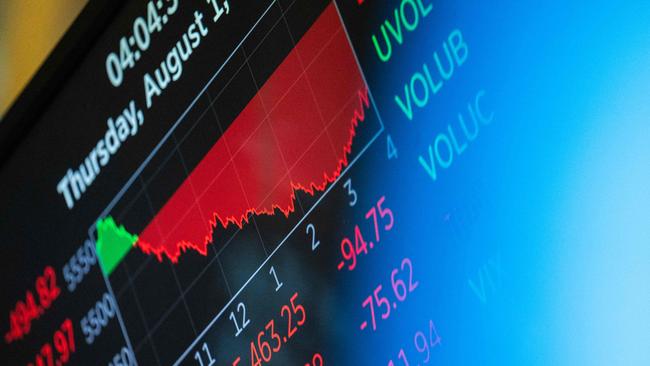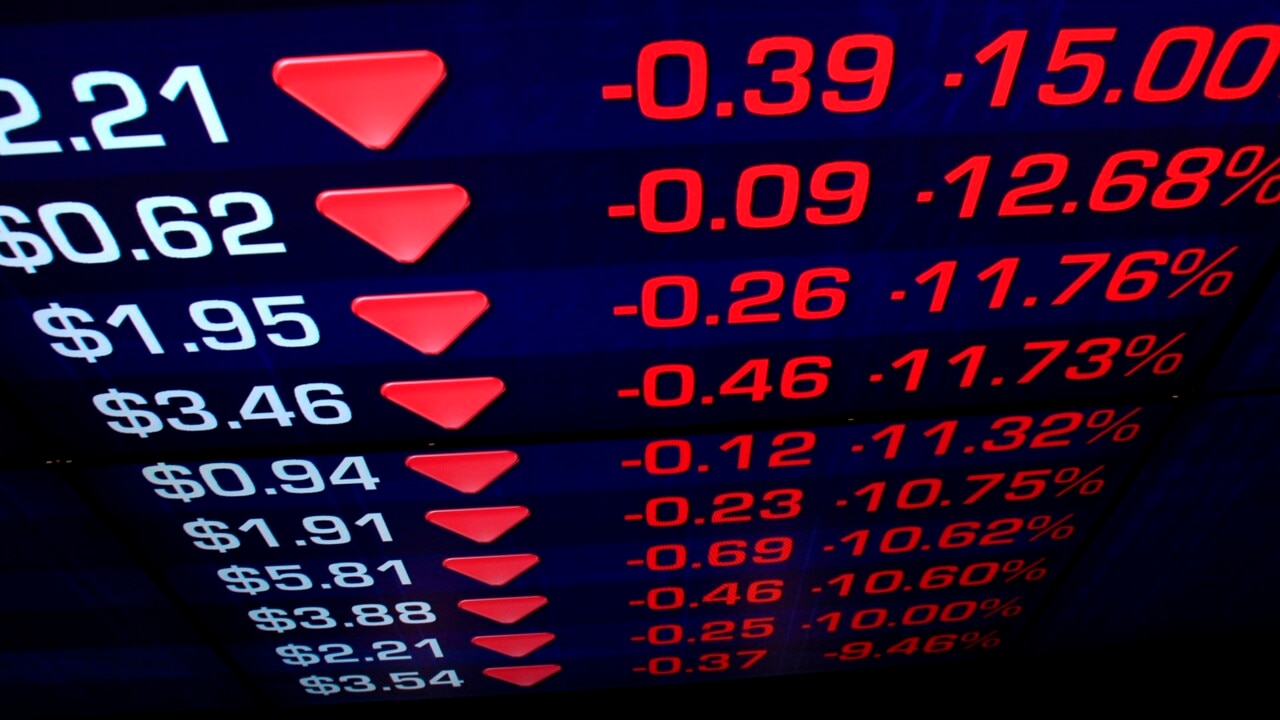Australian share market falls 3.7pc, well along the path towards a correction
The reality is Australia is being thumped by an international arm wrestle over interest rates. The sheer weight of global capital being readjusted means investors just need to buckle up.

Business
Don't miss out on the headlines from Business. Followed categories will be added to My News.
It’s taken just three sessions for the Australian share market to take a big step towards a correction. Bigger forces mean it might be hard for it to find its way back.
Wall Street’s selling wave continued into the Asian session, with Australia’s benchmark S&P/ASX 200 down a whopping 3.7 per cent on Monday. That marks the worst ASX session since May 2020, the depth of the pandemic.
There wasn’t panic selling among trading desk, but the magnitude of the fall was a surprise.
Japan’s Nikkei crashed nearly 13 per cent, Hong Kong down more than 2.6 per cent.
The US session was equally wild, Wall Street’s broad S&P 500 was down 3 per cent and the tech index Nasdaq was down 3,4 per cent. In one bright spot US futures have stabilised suggesting the worst of the selling bout is done for now.
Overnight VIX Index, the “fear gauge” of volatility, has jumped to the highest point since the depth of the pandemic pointing to deeper worries about stretched valuations. .
From a peak on July 10 the Nasdaq has hit a technical correction – a fall of more than 10 per cent from the peak.
From Monday’s loss, Australian shares are nearly 6 per cent from their peak. Ouch.
The higher they are, the harder the falls seems, and the latest sell-off comes after global equity markets – including Australia – have pushed fresh record highs in recent weeks.
The role of rates
The reality is Australia is being thumped by the global arm wrestle taking place over interest rates, and a hawkish hold in rates expected by the Reserve Bank on Tuesday will do little to change momentum here.
The sheer volume of global capital being reallocated mostly between bonds and shares and between the US and Japan, means Australian investors just need to hold on and hope.

The hits are coming from the unwinding of the carry trade, with last week’s rate hike by the Bank of Japan and bets of more hikes to come seeing money sucked out of shares there and into bonds.
The historic shift in Japan’s outlook is clashing with the increasing view of “too little, too late” when it comes to the Federal Reserve signalling its plans for US rates. What was thought unlikely a few months ago, the US could just hit the recession mark yet.
According to Matt Haupt, the lead portfolio manager for Wilson Asset Management Leaders, this is seeing the Japan carry trade rapidly unwinding. This is where funds have been borrowed cheaply in Japanese yen and reinvested into global shares and bonds. With rates on the rise in Japan the cash is going the other direction.
The Japanese yen, which has been extremely weak coming out of the global pandemic, was one of the strongest-performing currencies in recent days, surging again on Monday.
“You got a divergence in between the Bank of Japan and the (US) Fed at the moment, so just this flow of capital, and you could see it happening last week and the mechanics were well under way,” Haupt tells The Australian.
Even when there were celebrations on Wall Street last week when US Fed chair Jerome Powell signalled plans to push ahead with rate cuts, the carry trade was already starting to quietly unwind below the surface. Risky assets – read tech stocks or even bitcoin – are the first line to be sold off.

Weak US data
Signs of a weaker-than-expected US payrolls data, some earnings disappointment on the more expensive stocks such as Amazon and Intel, it was risk off.
Warren Buffett’s entry into the weekend where he sold half of his remaining holdings in magnificent seven tech play Apple added to the chill sweeping markets.
The sale of Apple and other holdings pumped up Buffett’s Berkshire Hathaway cash to a record high of $US277bn ($425bn). One of the world’s most astute investors cashing up is an ultraconservative signal for the market.
This suggests, not only has Apple hit the limits of its share price growth for now, but the spare cash will come in handy for a day of bargain hunting. That day hasn’t come yet.
Events like Buffett’s sale feed into the negative market loop. However, Haupt points out, we were already in a market where valuations were extended and crowded out in vogue.

Is fall just a blip?
While the risk off trade is clearly on, Haupt is taking a cautious view. For stockpickers such as Haupt the next three weeks will be key, with corporate Australia’s earnings season to give a real sense of where momentum is headed – as well as any pockets of pain. For some time now, Haupt has been tweaking his portfolio towards defensive sectors, such as health care and consumer staples.
The corporate slowdown is starting to be noticeable in the US, with margins starting to be squeezed, with some softer commentary around consumer spending and corporate activity. Australia is usually six months behind.
So too, Australian investors will be unforgiving on earnings misses around highest-priced stocks from Commonwealth Bank as well as discretionary retailers such as JB Hi-Fi that has run hard in recent weeks.
“It’s a matter of watching the outlook commentaries if there’s a distinct slowdown in consumption,” Haupt says.
The Fed will act
If the US slows down more severely than expected there is room for a return of the “Fed put”, says Nikki Thomas, a long-time stockpicker Magellan Financial.
That’s the reference to the tendency of former US Federal Reserve boss Alan Greenspan to use the cash rate lever to cushion shocks to the market and the economy.
Thomas isn’t ruling out a technical recession in the US, although anything deeper would have to be a significant deterioration. But with the cash rate there up to as much as 5.5 per cent “the Fed put is back in place”.
Thomas was speaking on the Future Generation’s latest Investing for Impact podcast series, with a new episode released this week.
“We’re going to see rate cuts. We’ve got inflation coming down. If economic growth deteriorates too quickly, the Fed will be on the cutting front,” she says. “They will drop away quantitative tightening; we will get the stimulus that always takes a while. But people should be reasonably relaxed that the tools are there if things started to deteriorate really badly”.
Depending on the data, if the US does hit a technical recession it will be mild, she believes.
Magellan has been a long-termer hold of US names such as Visa and MasterCard, McDonalds and even Yum Brands (owner of KFC in the US). It is the long-term exposure to tech names such as Amazon, Apple Microsoft and Netflix that has seen the wild swings of the fund. For the past six months its been all up as Nasdaq topped out at a record high, however since last week the mood has turned sharply negative for high-valued tech stocks.
With the US tech names handing down their quarterly results, the numbers might be good, however expectations built into the share price are stretched. That’s increasingly making it feel like the high-water mark. “It’s very hard for these companies to deliver a great result and get a share price benefit from that”. The numbers through the US reporting season represents more downside risk to US shares even if the numbers are quite good.
Longer-term investing into artificial intelligence should be played across two themes: the enablers or companies such as Microsoft, Nvidia or Amazon providing the AI infrastructure.
The second theme is the adopters or the companies where AI will benefit. The enablers are fighting it out for investment in the space, however for the adopters it’s still at an experimental stage, Thomas says. “We’re not at the point where the adopters are truly monetising any of it,” she says.
Thomas was one of the first to join Magellan when it was founded by Chris Mackay and Hamish Douglass more than two decades ago. She left for Alphinity investment in 2018, before rejoining Magellan in 2022. The growth fund was a different organisation she returned to with the exit of Douglass and a new management and board in place.
Thomas says China is still too difficult for a fund manager to find the right stocks. Not only the economic risk, but political risk is high. Interestingly she was planning a visit to China this year but cancelled because she couldn’t get the right kind of access.
Still, as investor you have to have a strategy because what China does is important on the global stage. This might be from manufacturing cheap EVs or ongoing demand for steel out.
Thomas is one of the portfolio managers who provides pro bono services to Future Generation, the listed fund that set up to deliver returns as well as social-impact investing. She was speaking to the fund’s chief executive, Caroline Gurney.
eric.johnston@news.com.au
More Coverage
Originally published as Australian share market falls 3.7pc, well along the path towards a correction





